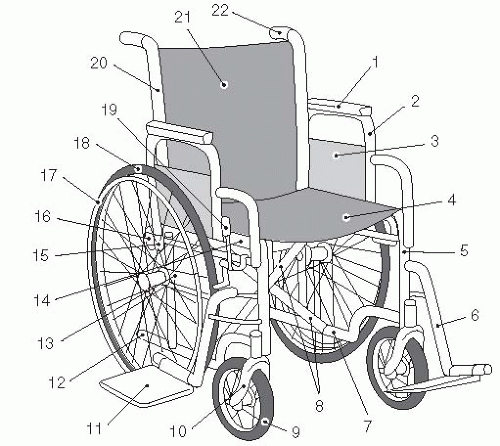Back height | Self-propeller, good trunk control | 2″ below inferior angle of scapula |
Self-propeller, poor trunk control | 2″ below scapular spine | |
Poor UEx strength, poor trunk control | Standard (typically 16.5”) | |
Seat width | Widest point, usually hip, plus 1″ | 18″ |
Seat depth | Buttock to popliteal fossa, minus 2″ | 16″ |
Seat height | Popliteal fossa to floor, plus 2″ | 19″ |
WC width | 18″ seat width usually corresponds to 27″ WC width. (Doorways need to have a clearance that is ≥32″ wide to be ADA compliant) | |
Standard (no set definition) | ˜43-50 lbs | |
Lightweight | <35 lbs | |
Ultralightweight (i.e., sports chairs) | <28 lbs | |
Heavy duty (for users >250 lbs) | 45-60 lbs | |
Wheel size | Standard | 24″ |
“Hemichair” | 20″ | |
a Decreasing the weight of a manual WC does not necessarily increase propulsion efficiency on level surfaces, but a difference is appreciable on uphill grades. | ||
Courtesy of Redford J, ed. Orthotics Etcetera. 3rd ed. Philadelphia, PA: Williams & Wilkins; 1986. | ||
Medical history
Home environment
Method of transportation

Figure 3-1 Components of a typical outdoor sling-seat WC. 1. Arm pad; 2. Desk-style removable arm rest; 3. Clothes guard; 4. Sling seat; 5. Down tube; 6. Footrest; 7. Bottom rail; 8. Cross brace, X bar, or X frame; 9. Caster; 10. Caster fork; 11. Footplate; 12. Tipping lever; 13. Axle; 14. Seat rail; 15. Arm rest bracket or hole for non-wraparound arm rest; 16. Arm rest bracket or hole for wraparound arm rest; 17. Handrim; 18. Wheel; 19. Wheel lock; 20. Back post; 21. Sling back; 22. Push handle.
Stay updated, free articles. Join our Telegram channel

Full access? Get Clinical Tree

 Get Clinical Tree app for offline access
Get Clinical Tree app for offline access





